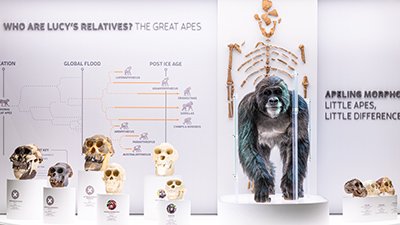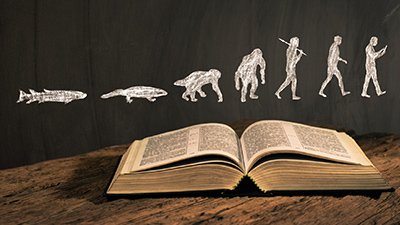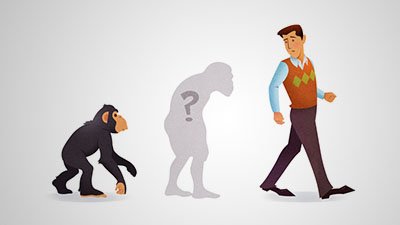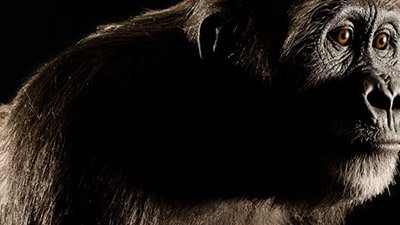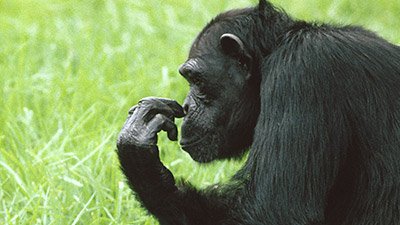
Lucy
Lucy, a partial Australopithecus afarensis fossil discovered in 1974 in Ethiopia, is a supposed human ancestor. It’s claimed she was bipedal due to human-like fossil footprints discovered 1000 miles away that are considered too early to be human. Yet the anatomical evidence is consistent with a fully ape classification for Lucy.
Lucy: Did She Walk Upright?
Most people don’t realize that the case for a human-like Lucy mainly depends on fossilized footprints. These impressions found at Laetoli in Tanzania are indistinguishable from human footprints you’d find on a beach. So, how do we know they weren’t packed down by Homo sapiens?
Lucy, a Knuckle-walking “abomination”?
Our Creation Museum exhibit features a holographic representation of Lucy’s fossilized bones in the context of the knuckle-walking ape that evidence suggests she was. A well-known blogger calls our Lucy “an abomination” and a “travesty.” He builds a detailed case intended to discredit the exhibit and demonstrate that Lucy was a transitional form between humans and ape-like ancestors.
Lucy, Swinging in the Trees?
To support their contention that ape-like ancestors became human because they learned to walk upright, evolutionists would like to bring Lucy down from the trees. But paleoanthropologists David Green and Zeresenay Alemseged have determined Lucy’s cousins retained their anatomical equipment for swinging through the forest and therefore likely did just that.
News About Lucy
-
June 22, 2023 from Ken Ham Blog
“3D Muscle Reconstruction Reveals 3.2 Million-Year-Old ‘Lucy’ Could Stand As Erect as Modern Humans,” popular science headlines declare.
Articles About Lucy
-
Aug. 31, 2025 from Answers in Depth
Is human evolution true just because many well-publicized “experts” keep shouting it’s true?
-
Oct. 24, 2021 from Answers Magazine
Since the famous ape skeleton dubbed Lucy was discovered in 1974, researchers have debated how much time she spent in trees.
-
Oct. 13, 2016 from Answers in Depth
The authors of a study in Nature claim to have solved human history’s oldest cold case: how and why our iconic, supposed ancestor Lucy died.
-
April 1, 2016 from Answers Magazine
Researchers have unearthed some intriguing human-like fossils. Did ape-men once walk on the earth, and should it matter to Christians?
-
Nov. 24, 2015 from Answers in Depth
Perhaps more than any other fossil, Lucy is presented as “exhibit A” for evolutionists in their attempt to show that humans evolved from an ape-like ancestor.
-
In-Depth ArticleLucy Makeover Shouts a Dangerously Deceptive Message About Our Supposed AncestorsOct. 5, 2013 from Answers in Depth
Australopithecus afarensis newest reconstruction drags Lucy down-to-earth.
-
Lucy Makes Last Stop Before Returning HomeFeb. 23, 2013 from News to Know
This spring is your last chance to see Lucy in the United States before she returns to her homeland.
-
Modern People Can Climb Trees, Why Not Lucy?Jan. 19, 2013 from News to Know
Evolutionary researchers have long been planting Lucy’s australopithecine feet firmly on the ground to show she evolved to walk bipedally along an evolutionary path to becoming human.
-
Jan. 1, 2013 from Answers Magazine
Lucy is the poster girl of human evolution, a member of the same family from which modern humans arose. At least, that’s how secular artists present her.
-
Interactive Lucy ImageDec. 21, 2012
View an interactive 360° image of the Creation Museum’s model of Lucy, based on the fossil evidence of Australopithecus afarensis.
-
-
Semi-Technical In-Depth ArticleLucy, the Knuckle-Walking “Abomination”?Oct. 24, 2012 from Answers in Depth
A blog post critical of the Creation Museum’s “Lucy” exhibit shows reckless and unscientific reasoning.
-
Recreating Ancient VoicesAug. 18, 2012 from News to Know
I love Lucy’s voice: it sounded just like an ape!
-
Magazine Department ArticleLucy ExposedJune 22, 2012 from Answers Magazine
On its fifth anniversary weekend, the Creation Museum opened a new high-tech exhibit on human origins.
-
Laetoli Footprints RevisitedNov. 12, 2011 from News to Know
A second look at Laetoli still asks the wrong question.
-
Magazine Department ArticleA Giant Leap for LucyJuly 1, 2011 from Answers Magazine
The discovery of a new foot bone for Lucy teaches us a valuable lesson—the less evidence available, the more interpretation is needed to make any conclusions.
-
Lucy on the Ground With High HeelsFeb. 12, 2011 from News to Know
New research suggests that “if Lucy were alive today, she could fit in high heels or march for miles without breaking her feet”—evidence, researchers claim, that Lucy was an experienced upright walker
-
Magazine Department ArticleLucy’s Great Grandfather?Oct. 1, 2010 from Answers Magazine
An alleged relative of the famous “ape-woman” Lucy has been discovered.
-
Meat-Butchering Tools for "Lucy"Aug. 14, 2010
Did the friends and family of supposed ape-woman “Lucy” use tools to butcher meat for meals?
-
Magazine Department ArticleThey Love LucySept. 8, 2008 from Answers Magazine
Ethiopia “loans” secular U.S. museums its famous native “daughter”—a supposedly 3.2 million-year-old hominid named Lucy.
-
Aug. 20, 2008 from Answers Magazine
Before humans left Babel, it appears that apes had already spread over much of the Old World and had diversified.
-
Lucy-Worship in HoustonSept. 8, 2007
Lucy, the “holy grail” of evolution according to some pundits, has arrived and is now on display at the Houston Museum of Natural Science in Texas.
-
More Lucy-Like Fossils Appear in EthiopiaJuly 14, 2007
A new “cache” of fossil remains belonging to what are described as “early human ancestors” has been discovered in the Woranso-Mille area of Ethiopia.
-
Lucy Fossil Soon to Visit AmericaJune 30, 2007
Scientists approve Lucy fossil for travel to the United States.
-
Semi-TechnicalFarewell to “Lucy”April 18, 2007
The field of paleoanthropology and the evolution of man is more fraught with controversy than probably any other field of evolutionary studies.
-
Semi-Technical In-Depth ArticleLucy’s Child, “Selam,” from EthiopiaNov. 1, 2006 from Answers in Depth
The morphology of this new fossil discovery and the lack of transitional forms indicate that this fossil discovery has no relevance to human origins.
-
Lucy and Her “Child” Look Like Extinct Apes After AllSept. 26, 2006
The field of human origins is a very fast-paced area. Indeed, almost every new hominid fossil that is found causes a reshuffling of the human evolutionary tree.
-
Lunatics, Lucy, and a Little Nook for the School LibraryAug. 25, 2004
The Australian Skeptics have donated copies of Helen Lawrence’s booklet, Making Friends with Fossils: How to Find Your Way Through the Maze of Human Origins, to schools across Australia.
-
Semi-Technical Research PaperDid Lucy Walk Upright?Aug. 1, 2001, pp. 9–10
For over 20 years, Lucy or Australopithecus afarensis has been considered one of our first ‘ancestors’, mainly because it supposedly walked upright.
-
Magazine ArticleEvolutionists “Go Ape” Over New FossilsMarch 1, 1999, pp. 49–50
It’s already being hailed as a “momentous discovery”—the ultimate “missing link” in human evolution.
-
Magazine Article“Ape-Woman” Statue Misleads Public: Anatomy ProfessorDec. 1, 1996, pp. 52–53
The St Louis zoo in Missouri, USA, has a $17.9 million exhibition majoring on evolution, which includes a statue showing remarkably human–looking feet.
-
Magazine Article“Lucy” isn’t the “Missing Link!”June 1, 1990, pp. 32–33
‘Lucy’ is the popular name given to the famous fossil skeleton found in 1974 in Ethiopia by American anthropologist Donald Johanson.
Recommended Resources

Answers in Genesis is an apologetics ministry, dedicated to helping Christians defend their faith and proclaim the good news of Jesus Christ.
- Customer Service 800.778.3390
- Available Monday–Friday | 9 AM–5 PM ET
- © 2025 Answers in Genesis


